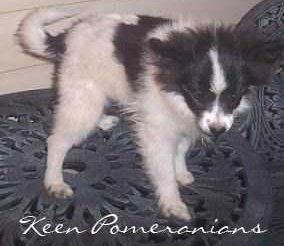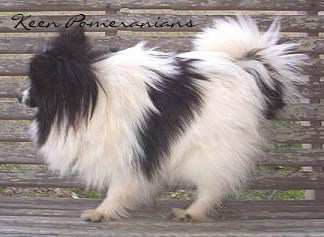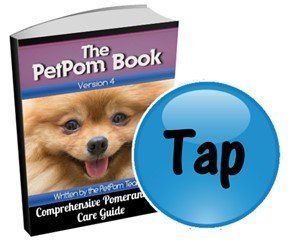Fur Issues
PetPom

The
Pomeranian
Information
Center
A Pom's Fur
How Many Coats Does the Pomeranian Have?
Poms have two coats, as most Spitz breeds do. The Pom originated from larger, cold-weather sled dogs of the Arctic. The trait of having 2 layers is common with outdoor dogs and even though the Pom was drastically bred down in size during its development; the trait of 2 layers stayed with the breed.
An adult Pomeranian has a short undercoat of dense hairs and a long top coat of guard hairs. These 2 layers blend into each other.
Puppies will have a much different appearance than adults. Puppy coats are soft and short. As the Pom matures, there is a drastic change. The soft puppy coat falls out and is replaced by the 2 layered adult coat.
The Age a Pom Grows His Adult Coat
Over the course of the first year, a Pomeranian puppy will have a gradual loss of puppy fur that is replaced by his adult coat.. When a Pom is just about 1 year old, he will have his adult coat.
Color Change
It is extremely normal for a Pomeranian's fur to change color as the Pom matures. It happens more often than not. This element is one of the exciting things about owning a Pom. He will be one color as a pup and a different color as an adult dog. Many things can happen to the fur, sabling or brindling may lighten or darken, the whole coat of fur can fade (brown to cream) or become deeper (orange to red) and so forth.
Tips to Keep a Pomeranian's Fur Healthy
Without proper care, a Pom's fur will become very dry, brittle and end break off. And a good care routine
will keep it fluffy, healthy and able to grow. Here are some things you can do:
1) Never brush a dry coat - Always mist the fur with a light leave-in spray before you do any brushing at all
2) Groom the coat on a regular basis, whether or not it appears to need it or not. Since the fur is so dense, there will be matted pieces and dirt & debris near the skin where you cannot see it.
In addition, regularly brushing out dead hairs from the coat will improve skin health. Dead fur stuck near the skin blocks healthy air circulation and promotes build up of body oils. This can lead not only to an odd smell, but also skin issues. And if the skin is not healthy, the fur will not be either. For this reasons, brushing at least every other day is recommended.
3) Protect the fur from the damaging sun of the summer
and the damaging dry air of the winter by using a light leave-in conditioner. This also protects the coat from static that can build up and protect fur strands from friction (fur against carpeting, etc.)
4) Fur can grow too long and this can make the coat flat. If your Pom's fur does not have the fluffy look that you wish for, this is often the reason. A nice trim - not too much - but just enough to tidy things up, will allow the outer guard hairs to stand out as they should.
5) Omega 3 fatty oils are super great for a Pomeranian's fur. Break open a capsule and drizzle this on 1 meal per day.
6) Be very choosy regarding which products you apply to your Pomeranian's fur. This includes shampoo, conditioner and leave-in spray.
Also, be very choosy regarding what tools touch your Pom's fur. This includes both the brush and comb. A cheap dog brush can rip the hairs and ruin a coat in one grooming session.
Fur Loss as a Puppy
Puppy Uglies -
If an owner is not expecting it, this can be a shocking growth phase. This breed - as he matures - has a drastic loss of fur during the time that the puppy coat is falling out to make way for the adult coat. This is referred to as the Puppy Uglies. Though, one must always be aware that other issues can cause this as well (more ahead).

Before - A 5 month old Pomeranian with severe fur loss. No worries! This is just the 'Puppy Uglies' stage.
Photo courtesy of Keen Pomeranians

After - At 11 months old, the adult coat is growing in nicely. The fur will still grow a bit longer; however this Pom made a major change from the 'before' photo!
Photo courtesy of Keen Pomeranians
Many owners become nervous during this time, because the pictures of Pomeranians with super fluffed fur are splattered everywhere, but not so much when a Pom temporarily looks like this.
When does a Pomeranian first lose its fur? It usually happens when the puppy is 4 to 6 months old. This is not set in stone. Fur loss from Puppy Uglies may happen early, at 3 months or late at 7 months. When the fur falls out, it does not always happen evenly. You may see a severe loss of hair just around the eyes. You may see patches all over the dog's back. There is no rhyme or reason for this;it is a natural part of growing up.
While this is the most common cause of fur loss during the puppy stage, do keep an eye out for other signs that may point to another cause.
Severe allergies and other conditions may also have symptoms that include: red, irritated skin, loss of appetite, water eyes and/or scratching.
Note:
Fur is what the Pom is known for...their most outstanding feature! For this reason, an owner should be aware of every fur issue that affects this dog breed. Find out more our book - Now in PRINT and eBook.
Other Reasons for Fur Problems
We talked about the Puppy Uglies and that fur loss is normal when a Pomeranian dog is a 3 to 7 month old puppy, give or take several months. However there may be times beside this when your Pomeranian's fur is falling out. Though it can be alarming, it is important to be able to stay calm and look at the situation so that you can determine if it is a serious issues or just a normal phase that this breed can experience.
*** Have you seen a true pink Pom? How about a lavender one? For the most comprehensive color info anywhere & details regarding 12 Pomeranian fur issues, check out the PetPom book.
Seasonal Shedding -
The Pomeranian is considered a moderate shedding dog. It is normal to pull some dead hairs from the coat all year round. Also, for many Poms, there will be a twice-per-year shed. There will, however, be Poms that shed more than others and those particular dogs could be placed in the 'heavy' shedder category. While it is changes in daylight hours that triggers this to happen, those that also live in areas with drastic weather changes (cold winters, hot summers) will see more shedding with their Poms than those that live in areas with more stable weather conditions.
Anesthetics -
For both males and females there can be hair loss with a Pomeranian after having anesthetics from surgery.
Female hormones -
With many females Pomeranians, fur will fall out during or after a heat cycle due to changing hormone levels. This is known as "blowing her coat". Pregnancy brings about big changes...A female can also shed quite a bit of fur after having puppies.
Stress -
Stress plays a factor as well, as this can affect the coat that is intact and affect any growth that is to happen
Red Mange -
With this, a dog develops an allergic reaction to microscopic mites that live on all dogs.
Allergies -
Allergies can make skin so dry and itchy that the fur suffers as well. Additionally, chewing and/or scratching can cause fur to fall out.
Thyroid issues -
While not exceedingly common with this breed, low thyroid levels can affect the coat.
Black Skin Disease/ Alopecia This will cause not only dry, brittle fur but also clumps of fur can fall out. In addition, the skin may
become discolored.
Skin
Often, coat issues go hand in hand with skin conditions. If the skin is irritated, it will affect hair growth,either in certain spots or in some cases, all over the body. We offer detailed advise regarding this, and you can read about it in our Pomeranian skin
section.
When Fur Does Not Grow Back
When a Pom has health issues which causes the fur to fall out or to thin; there is always a chance that the fur will not grow back as expected. This is called post loss alopecia and for this breed, the reason for this could be the rare BSD.
Studies are currently being done to understand alopecia further. However, as of now, it is thought that there are certain changes that take place in the dog's skin because of the temperature changes that occur when the fur is gone or very thin. When this happens, it can take up to 24 months for the Pomeranian's fur to grow back; though with some dogs the coat will never fully grown back. There has been some promising results in using Melatonin to help stimulate the hair follicles. You may wish to discuss the possibility of this with your dog's veterinarian. We have some additional information on the Pomeranian Hair Growth
page and the BSD
page.
If you email photos to us, you agree that PetPom is given free copyright to use at our discretion. We will always credit the photo to the name of the Pom's owner(s) if it is supplied.
Email: Contact@PetPom.com
All text, images and artwork protected by US and International copyright laws. All rights reserved. Copyright PetPom.com
We are a participant in the Amazon Services LLC Associates Program, an affiliate advertising program designed to provide a means for us to earn fees by linking to Amazon.com and affiliated sites.


